United States Analog Integrated Circuits Market Size
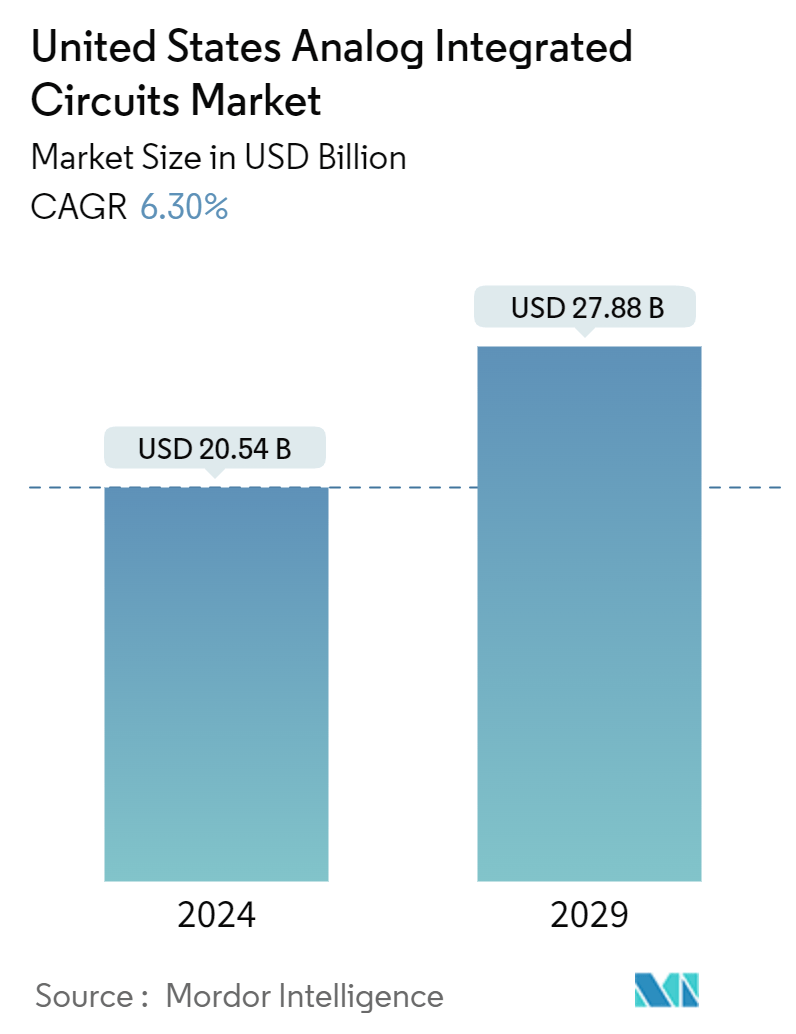
| Study Period | 2019 - 2029 |
| Base Year For Estimation | 2023 |
| Market Size (2024) | USD 20.54 Billion |
| Market Size (2029) | USD 27.88 Billion |
| CAGR (2024 - 2029) | 6.30 % |
| Market Concentration | Low |
Major Players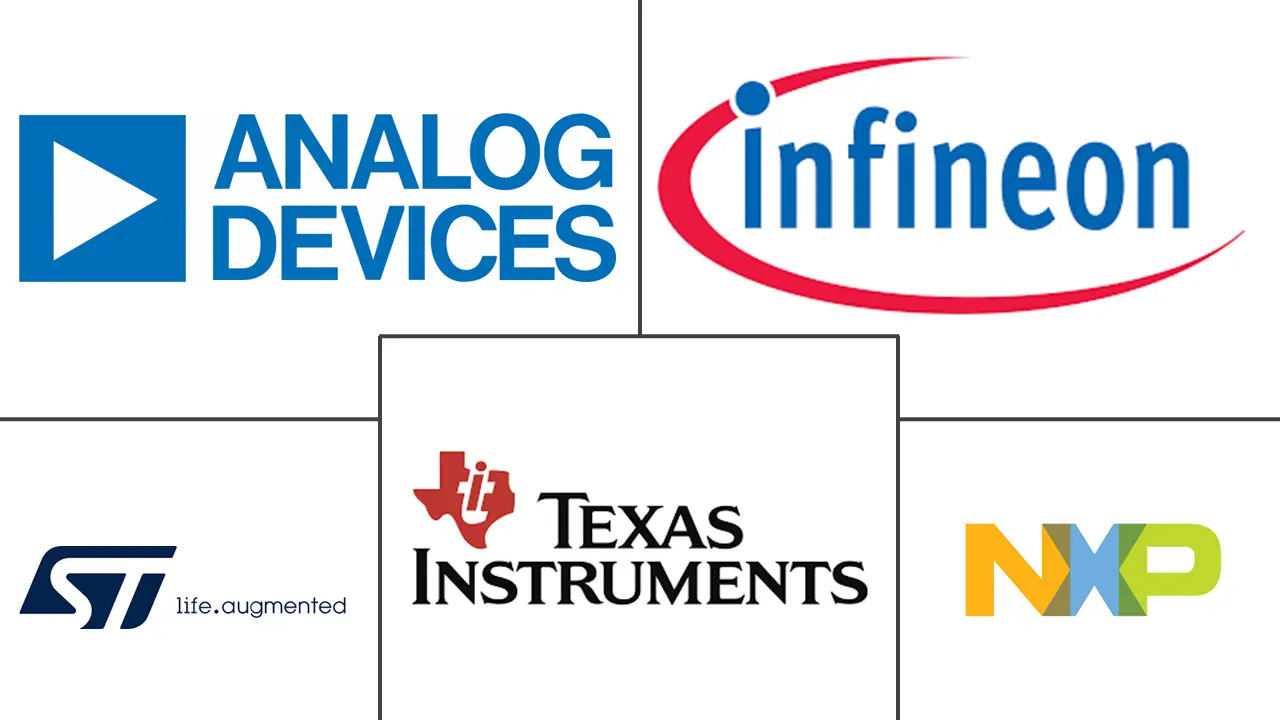
*Disclaimer: Major Players sorted in no particular order |
United States Analog Integrated Circuits Market Analysis
The United States Analog Integrated Circuits Market size is estimated at USD 20.54 billion in 2024, and is expected to reach USD 27.88 billion by 2029, growing at a CAGR of 6.30% during the forecast period (2024-2029).
- Analog integrated circuits (ICs) are essential components in many electronic devices designed to process continuous signals representing real-world phenomena such as sound, light, and temperature. Unlike digital circuits, which operate using discrete binary values (0s and 1s), analog circuits handle signals that vary smoothly over time, making them crucial for applications that require precise signal representation.
- One of the primary advantages of analog ICs is their ability to process continuous signals. This capability is essential for applications like audio processing, radio frequency operations, and sensor interfacing, where the signal nature is inherently analog. For instance, in audio equipment, analog circuits can directly manipulate the sound waves, resulting in a more natural sound reproduction compared to digital methods that require conversion processes.
- In many cases, analog circuits consume less power than digital circuits. This efficiency is particularly evident in low-frequency applications where the operational requirements do not demand high-speed switching. Lower power consumption directly contributes to longer battery life for battery-powered devices, such as sensors and portable electronics, making analog circuits an attractive choice.
- As IoT devices proliferate, the demand for low-power, high-performance analog ICs is anticipated to grow in the United States. These devices require efficient power management solutions and reliable analog-to-digital converters (ADCs) to process real-world signals. Innovations in low-power design techniques, such as sub-threshold operation and advanced power-saving modes, will be critical in meeting the stringent energy efficiency requirements of IoT applications.
- The shift toward smart homes in the United States has increased the need for analog ICs in devices such as smart thermostats, security systems, and lighting controls, which require robust analog components for sensor interactions and control systems.
- Furthermore, the increasing importance of artificial intelligence (AI) and machine learning (ML) is poised to reshape the analog IC landscape in the United States. The integration of AI algorithms into analog IC designs can lead to smarter devices capable of adapting to varying conditions and optimizing performance in real-time. This trend is expected to encourage the development of analog circuits that are not only capable of processing traditional signals but are also equipped with intelligent features.
- However, the complex design process, which requires high precision and customization for specific applications, leads to increased development costs and acts as a major restraint to the growth of the market studied.
- The increased inflation and interest rates reduced consumer spending, hampered the semiconductor and electronics demand, and led to slow growth in the market. The trade war between the United States and China also disturbed the global semiconductor supply chain. Owing to strict export and import controls on semiconductor manufacturing equipment in China by the United States, the production of the consumer electronics sector is compromised.
United States Analog Integrated Circuits Market Trends
Power Management IC Segment Anticipated to Drive Demand
- Power management integrated circuits (PMICs) are crucial components in modern electronic devices, playing a crucial role in managing power distribution, voltage regulation, and energy efficiency.
- PMICs are ubiquitous in consumer electronics. Devices such as smartphones, laptops, tablets, and wearable devices rely on PMICs to optimize battery life and performance. PMICs manage the charging and discharging cycles of batteries, regulate output voltages for different components, and provide power sequencing for various subsystems. For instance, in smartphones, PMICs help efficiently manage power for the display, processors, and wireless communications, ensuring that the device operates smoothly while maximizing battery efficiency.
- The telecommunications sector also extensively uses PMICs, particularly in base stations and network infrastructure. PMICs regulate the power supply to various components such as amplifiers, processors, and cooling systems, ensuring that these systems operate efficiently and reliably under varying load conditions. With the transition to 5G networks, the demand for efficient power management solutions has intensified, as higher frequencies and increased data rates require more sophisticated power management strategies.
- As computing demands increase, especially with the growth of cloud services and data centers, efficient power management becomes paramount. PMICs are employed in servers and high-performance computing systems to regulate voltages for CPUs, GPUs, and other critical components. This regulation not only improves energy efficiency but also enhances overall system performance. PMICs also play a role in power redundancy and reliability, ensuring that data centers can maintain operations even in the event of a power supply failure.
- The exponential growth of digital data and the emergence of cloud computing have led to increased demand for data centers in the United States. According to Cloudscene, as of March 2024, there were a reported 5,381 data centers in the United States, the most of any country worldwide.
- The country is also witnessing several investments in data centers. For instance, in June 2024, Google announced a significant investment plan to expand its data center campuses in Virginia and Indiana. Google has been significantly investing in expanding its data center footprint in the United States to power its cloud computing infrastructure and AI initiatives. The company announced its plans to invest USD 3 billion, with USD 1 billion allocated to expand three existing data centers in the United States. This investment is anticipated to bring Google's total investment in Virginia to over USD 4 billion.
- Moreover, in January 2024, Vantage Data Centers, a prominent global provider of hyperscale data center campuses, announced a USD 6.4 billion equity investment led by investment vehicles managed by DigitalBridgeGroup Inc., a global alternative asset manager committed to investing in digital infrastructure, and Silver Lake. These investments are anticipated to accelerate and extend Vantage's strategic capabilities across North America and EMEA to partner with global hyperscalers in meeting unprecedented cloud and AI demand. Such investments are likely to drive the growth of the market studied.
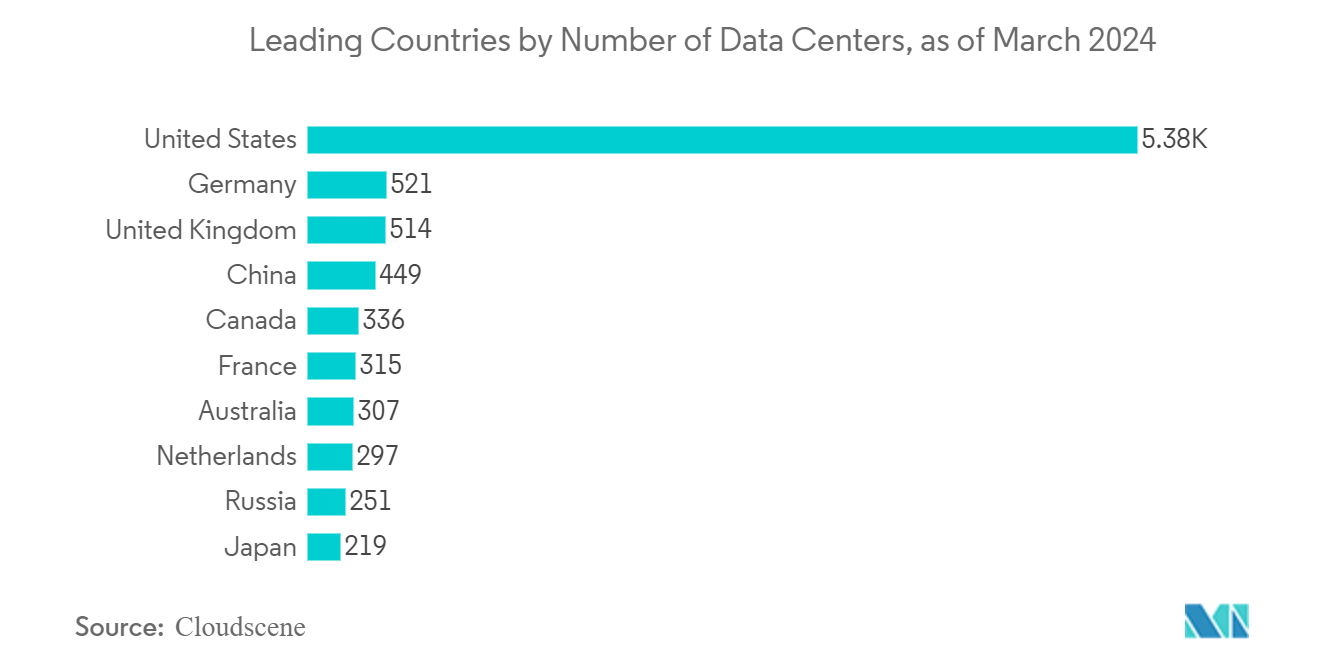
Automotive Sector Anticipated to Hold a Major Market Share
- Analog integrated circuits play a vital role in the automotive industry, enhancing vehicle performance, safety, and efficiency. One of the most significant applications of analog ICs is in automotive sensor systems. Sensors monitor critical parameters such as temperature, pressure, and position.
- For instance, in engine management systems, analog ICs process signals from temperature and pressure sensors to optimize fuel injection and ignition timing, leading to improved fuel efficiency and reduced emissions. Moreover, analog front-end circuits in tire pressure monitoring systems (TPMS) ensure accurate readings of tire pressure, contributing to enhanced safety and performance.
- The United States is one of the largest automotive markets in the world. Being home to prominent automotive industry leaders, such as General Motors, Ford, and Chryslers, vehicle production in the country is growing significantly. With the growing usage of cars, the demand for smart parking is also growing, propelling the demand for compact camera modules for application in parking surround view. According to BEA, at just under 1.07 million unit sales, light trucks remained the most significant auto market segment in the United States in May 2023, down from over 1.07 unit sales in April 2023 and increasing by approximately 23.06% year-on-year.
- Another significant application is in power management systems. Analog ICs are essential for managing power distribution and conversion within vehicles. They regulate voltage levels for various components, ensuring they operate within specified ranges. For electric and hybrid vehicles, analog ICs are crucial for battery management systems (BMS), monitoring cell voltages, temperatures, and overall battery health to maximize performance and lifespan.
- In infotainment and communication systems, analog ICs facilitate audio processing, signal conditioning, and interfacing with various input devices. They enhance audio quality in in-car sound systems, enabling features like noise cancellation and equalization. Furthermore, analog ICs are integral in vehicle-to-everything (V2X) communication systems, where they help process signals for vehicle safety and traffic management by enabling real-time data exchange between vehicles and infrastructure.
- Safety systems also heavily rely on analog ICs. In advanced driver-assistance systems (ADAS), these circuits process data from cameras, radar, and lidar sensors to support features like lane-keeping assistance, adaptive cruise control, and collision avoidance. The precision and reliability of analog ICs are critical for the timely response of these safety features.
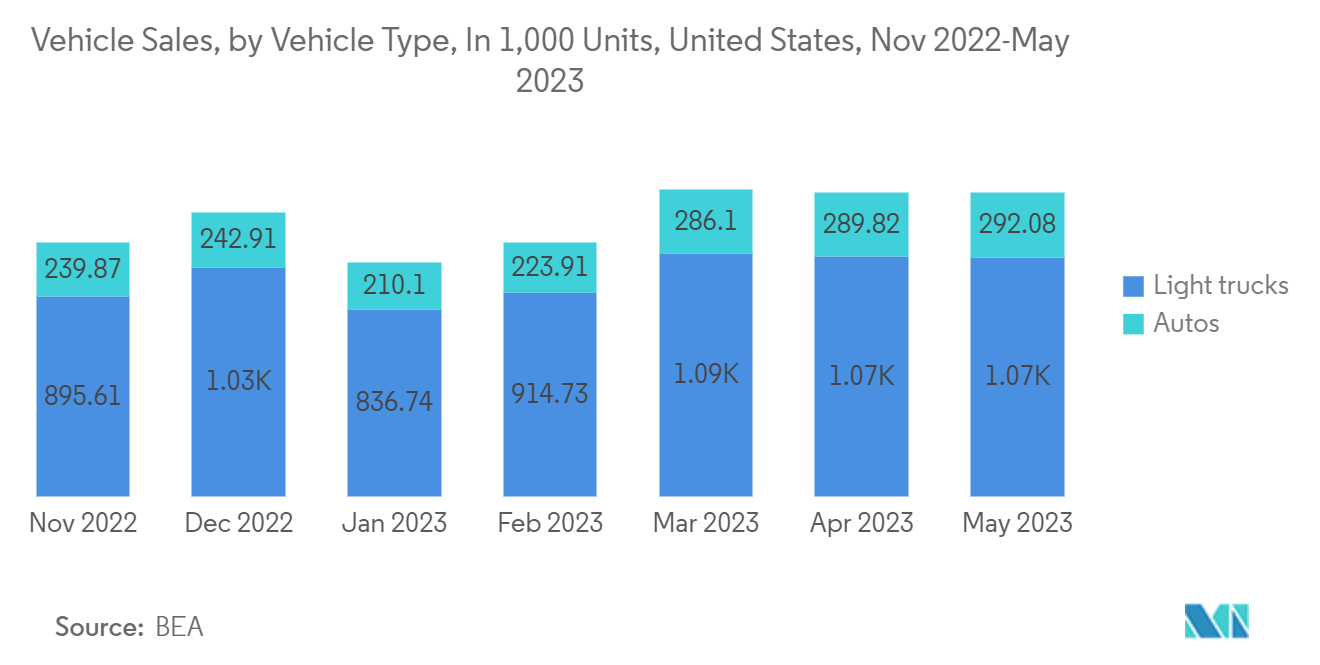
United States Analog Integrated Circuits Industry Overview
The analog integrated circuits market in the United States is fragmented with the presence of several major players like Analog Devices Inc., Infineon Technologies AG, Microchip Technology Inc., NXP Semiconductors NV, Texas Instruments Inc., etc. Market participants strategically leverage partnerships and acquisitions to bolster their product portfolios and establish a sustainable competitive edge.
- January 2024: Damon Motors Inc. announced a collaboration with NXP Semiconductors, a prominent company in automotive processing and a renowned provider of vehicle electrical/electronic (E/E) architecture and electrification solutions. This collaboration has integrated NXP's advanced technology into Damon's electronic control units (ECU) and other electronic systems.
- October 2023: Skyworks Solutions Inc. introduced its Si469xx family of automotive digital radio coprocessors for future in-vehicle infotainment (IVI) systems. Skyworks' Si469xx family of coprocessors, known for their integration, flexibility, and affordability, is touted as a suitable match for the Si479xx Hybrid Software Defined Radio (SDR) Tuners. Together, they are claimed to offer a budget-friendly digital radio receiver. The Si469xx series boasts advanced features like maximal ratio combining (MRC) and the smooth integration of digital radio, analog radio, and internet protocol content.
United States Analog Integrated Circuits Market Leaders
-
Analog Devices Inc.
-
Infineon Technologies AG
-
STMicroelectronics N.V.
-
Texas Instruments Inc.
-
NXP Semiconductors N.V.
*Disclaimer: Major Players sorted in no particular order
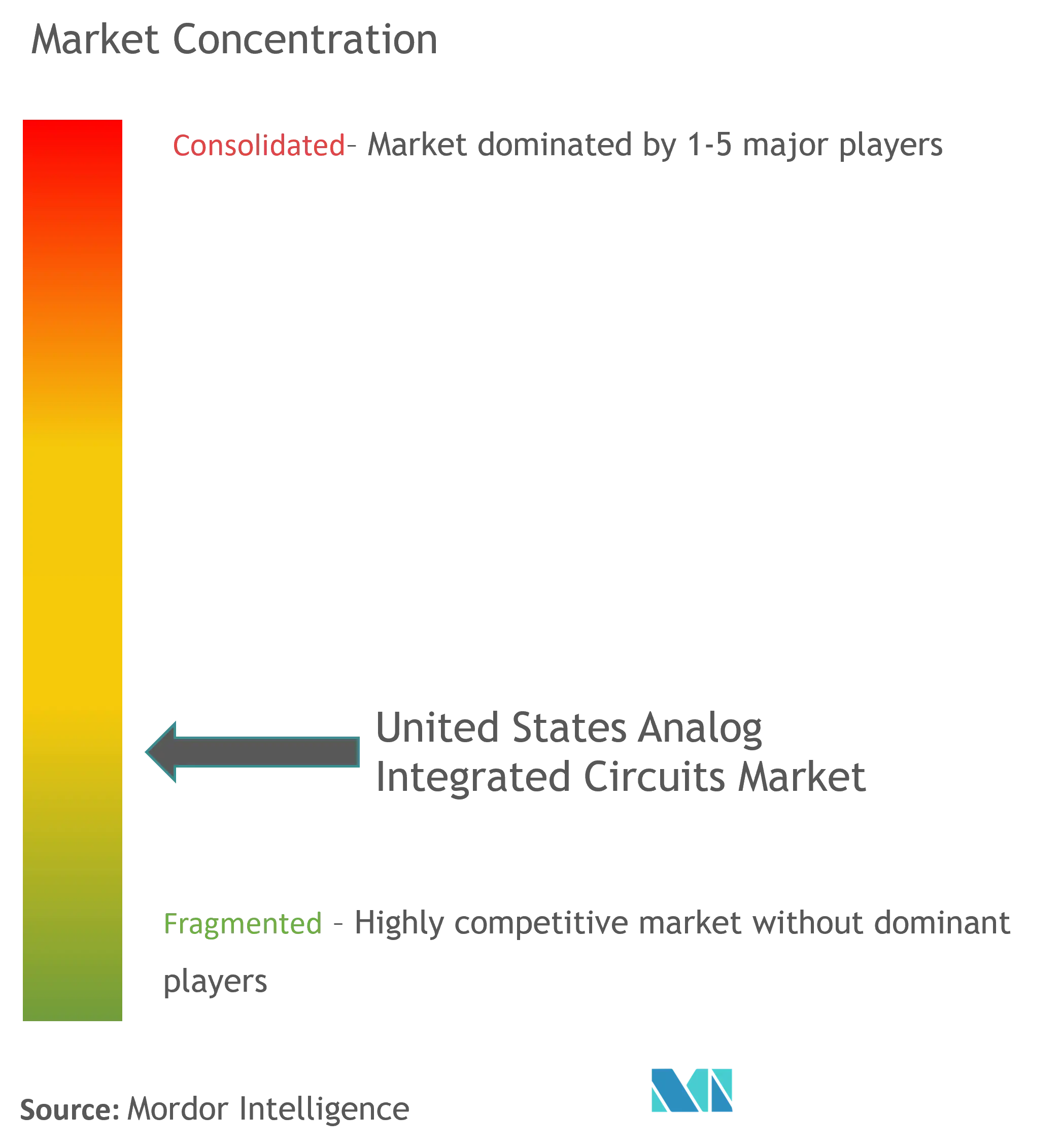
United States Analog Integrated Circuits Market News
- April 2024: STMicroelectronics announced a new process technology to design and build transistors for next-generation embedded processing devices. The advanced technology is based on an 18 nm fully depleted silicon on insulator (FD-SOI) process with embedded phase change memory. This is claimed to have reduced the feature size to 18 nm from 20 nm. PCM technology uses changes in the material phase to store data. It also supports 3 V operation for analog features and delivers the reliability required for demanding industrial applications like high-temperature operation, radiation hardening, and data retention capabilities.
- April 2024: Infineon Technologies AG introduced its PSoC4 HVMS family of automotive microcontrollers, which integrate high-voltage features (12 V regulator and LIN/CXPI transceiver) in combination with advanced analog features (CAPSENSE and Inductive sensing). The controllers are ISO26262 compliant and ISO21434 ready. Additional analog integration includes a 12-bit SAR ADC, up to two operational amplifiers, and low-power comparators.
United States Analog Integrated Circuits Market Report - Table of Contents
1. INTRODUCTION
1.1 Study Assumptions and Market Definition
1.2 Scope of the Study
2. RESEARCH METHODOLOGY
3. EXECUTIVE SUMMARY
4. MARKET INSIGHTS
4.1 Market Overview
4.2 Industry Attractiveness - Porter's Five Forces Analysis
4.2.1 Bargaining Power of Suppliers
4.2.2 Bargaining Power of Consumers
4.2.3 Threat of New Entrants
4.2.4 Threat of Substitute Products
4.2.5 Intensity of Competitive Rivalry
4.3 Industry Value Chain Analysis
4.4 Impact of COVID-19 Aftereffects and Other Macroeconomic Factors on the Market
5. MARKET DYNAMICS
5.1 Market Drivers
5.1.1 Rising Penetration of Smartphones, Feature Phones, and Tablets
5.1.2 Increasing Adoption of Industrial Automation
5.1.3 The Growing Emphasis on Energy Efficiency Across Various Sectors
5.2 Market Restraint
5.2.1 Increasing Design Complexity of Analog IC
6. MARKET SEGMENTATION
6.1 By Type
6.1.1 General-purpose IC
6.1.1.1 Interface
6.1.1.2 Power Management
6.1.1.3 Signal Conversion
6.1.1.4 Amplifiers/Comparators (Signal Conditioning)
6.1.2 Application-specific IC
6.1.2.1 Consumer
6.1.2.1.1 Audio/Video
6.1.2.1.2 Digital Still Camera and Camcorder
6.1.2.1.3 Other Consumer
6.1.2.2 Automotive
6.1.2.2.1 Infotainment
6.1.2.2.2 Other Automotive Infotainment
6.1.2.3 Communication
6.1.2.3.1 Cell Phone
6.1.2.3.2 Infrastructure
6.1.2.3.3 Wired Communication
6.1.2.3.4 Short Range
6.1.2.3.5 Other Wireless
6.1.2.4 Computer
6.1.2.4.1 Computer System and Display
6.1.2.4.2 Computer Periphery
6.1.2.4.3 Storage
6.1.2.4.4 Other Computer
6.1.2.5 Industrial and Others
7. COMPETITIVE LANDSCAPE
7.1 Company Profiles*
7.1.1 Analog Devices Inc.
7.1.2 Infineon Technologies AG
7.1.3 Microchip Technology Inc
7.1.4 NXP Semiconductors NV
7.1.5 On Semiconductor Corporation
7.1.6 Richtek Technology Corporation (MediaTek Inc.)
7.1.7 Skyworks Solutions Inc.
7.1.8 STMicroelectronics NV
7.1.9 Texas Instruments Inc.
7.1.10 Renesas Electronics Corporation
7.1.11 Qorvo Inc.
8. INVESTMENT ANALYSIS
9. FUTURE OF THE MARKET
United States Analog Integrated Circuits Industry Segmentation
For market estimation, the revenue generated from sales of various types of analog integrated circuits used in a diverse range of industries, such as consumer, automotive, communication, computer, industrial, etc., is tracked. Market trends are evaluated by analyzing investments made in product innovation, diversification, and expansion. Enhancements in 5G, IoT, AI, energy efficiency, artificial intelligence, autonomous systems, electric vehicles, and biomedical devices are also crucial in determining the growth of the market studied.
The analog integrated circuits market in the United States is segmented by type (general-purpose IC (interface, power management, signal conversion, and amplifiers/comparators), application-specific IC (consumer (audio/video and digital still camera & camcorder, and other consumers), automotive (infotainment and other automotive application ICs), communication (cell phone, infrastructure, wired communication, short range, and other wireless), computer (computer system & display, computer periphery, storage, and other computers), and industrial and other analog IC types)). The market sizes and forecasts are provided in terms of value (USD) for all the above segments.
| By Type | |||||||||||||||||||||||||
| |||||||||||||||||||||||||
|
United States Analog Integrated Circuits Market Research FAQs
How big is the United States Analog Integrated Circuits Market?
The United States Analog Integrated Circuits Market size is expected to reach USD 20.54 billion in 2024 and grow at a CAGR of 6.30% to reach USD 27.88 billion by 2029.
What is the current United States Analog Integrated Circuits Market size?
In 2024, the United States Analog Integrated Circuits Market size is expected to reach USD 20.54 billion.
Who are the key players in United States Analog Integrated Circuits Market?
Analog Devices Inc., Infineon Technologies AG, STMicroelectronics N.V., Texas Instruments Inc. and NXP Semiconductors N.V. are the major companies operating in the United States Analog Integrated Circuits Market.
What years does this United States Analog Integrated Circuits Market cover, and what was the market size in 2023?
In 2023, the United States Analog Integrated Circuits Market size was estimated at USD 19.25 billion. The report covers the United States Analog Integrated Circuits Market historical market size for years: 2019, 2020, 2021, 2022 and 2023. The report also forecasts the United States Analog Integrated Circuits Market size for years: 2024, 2025, 2026, 2027, 2028 and 2029.
United States Analog Integrated Circuits Industry Report
Statistics for the 2024 United States Analog Integrated Circuits market share, size and revenue growth rate, created by Mordor Intelligence™ Industry Reports. United States Analog Integrated Circuits analysis includes a market forecast outlook for 2024 to 2029 and historical overview. Get a sample of this industry analysis as a free report PDF download.



